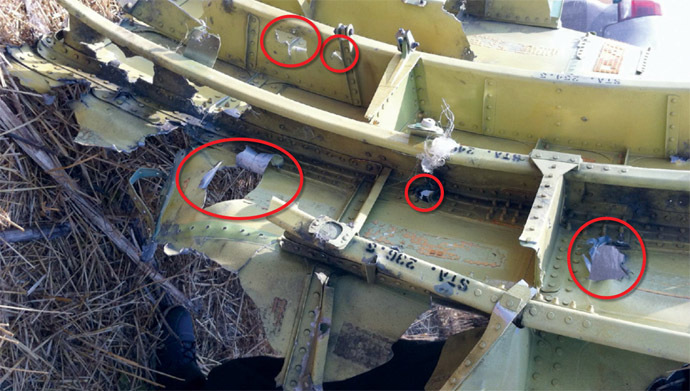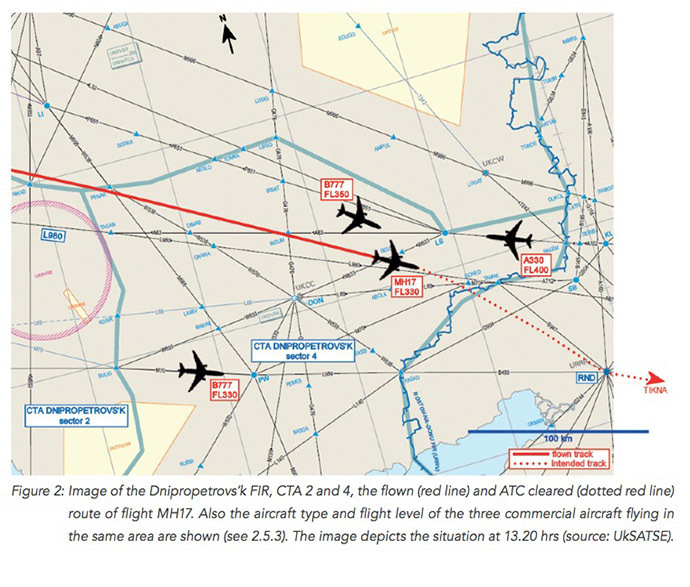Comment: So the much-delayed 'preliminary report' on MH17 has finally been released, and it's no surprise that it doesn't say anything much of relevance that we didn't already know. What's interesting is that their explanation of the cause of the crash is phrased in such a way as to be compatible with all the main rivaling positions: a Russian/Novorossiyan Buk, or a Ukrainian Buk or jet. In other words, the mainstream presstitutes and spineless politicians can freely use it as more 'evidence' of Russia's involvement, even if it says nothing of the sort.
The MH17 crash was a result of structural damage caused by a large number of high-energy objects that struck the Boeing from the outside, the preliminary report into the Malaysia Airlines disaster in Ukraine said.
"Flight MH17 with a Boeing 777-200 operated by Malaysia Airlines broke up in the air probably as the result of structural damage caused by a large number of high-energy objects that penetrated the aircraft from outside," the Dutch Safety Board said in its preliminary report.
Dutch investigators added that "there are no indications" that the tragedy was triggered "by a technical fault or by actions of the crew."
'We need more analysis to investigate the crash" - Malaysian minister
Malaysian Transport Minister Liow Tiong Lai said on Tuesday that more analysis was needed to investigate the crash.
"We want to further analyze the data and the wreckage," he said, adding that more details were needed so that the authorities "will bring the perpetrators to justice."
Comment: You can bet that if evidence of Russian guilt had been found, they would have released it.
The Malaysia Airlines plane en route from Amsterdam to Kuala Lumpur with 298 people aboard crashed in Ukraine's Donetsk region on July 17. The majority of those on the plane - which was allegedly shot down - were citizens of the Netherlands.
Plane was 'split into pieces during flight'
The cockpit voice recorder, the flight data recorder and data from air traffic control all suggest that flight MH17 proceeded as normal until 13:20:03 GMT, after which it ended abruptly.
Comment: So has Kiev released the ATC recordings? When were they received? See: Moscow reminds UN that Kiev is still withholding MH17 traffic control communications
The cockpit crew made no emergency call, the radio communications with Ukrainian air traffic control shows.
"The final calls by Ukrainian air traffic control made between 13.20:00 and 13.22:02 [GMT] remained unanswered," the report said.
The plane was "split into pieces during flight," the investigators said, based on the analysis of the pattern of wreckage on the ground.
The Dutch investigators said that "available images show that the pieces of wreckage were pierced in numerous places."
The report emphasizes that investigators haven't yet had the chance to recover the components for forensic investigation.
Comment: For which we can blame Kiev, who refused to stop shelling the region of the crash site. In fact, wreckage is still sitting there.
However, the photos taken from the wreckage "indicated that the material around the holes was deformed in a manner consistent with being punctured by high-energy objects," the report said. "The characteristics of the material deformation around the puncture holes appear to indicate that the objects originated from the outside the fuselage."
Comment: While they make no mention of it, notice how the phrasing of this statement does not rule out that they also observed exit holes near entry holes, which, while technically 'originating from the outside', would suggest machine-gun fire, not a single Buk explosion. See: Did Kiev fighter jet shoot down Malaysian MH17 after mistaking it for Putin's plane?
The fact that the plane was damaged from the outside "also explains the abrupt end to the data registration on the recorders, the simultaneous loss of contact with air traffic control and the aircraft's disappearance from radar," the report says.
The report says that the flight recorder was "found damaged but the internal memory module was intact."
"The external damage found on the [flight data recorder] was consistent with impact damage."
The radar data from the aircraft shows that "three commercial aircraft were in the same Control Area" as the Malaysia Airlines plane.
Comment: No mention of the military jet seen by witnesses and caught on Russian radar systems.
"At 13.20 UTC [GMT] the distance between the closest aircraft and MH17 was approximately 30 kilometers," the document says.
Dutch investigators concluded that the Malaysian airliner was flying "in unrestricted airspace above the restricted area mentioned by the latest NOTAM [Notice to Airmen]." Commercial flights were restricted in the area below the flight level of FL320, MH17 was flying at FL330.
Full report to be released 'within a year of the crash' - Dutch Safety Board
Tjibbe Joustra, chairman of the Dutch Safety Board, said that the plane tragedy in eastern Ukraine "shocked the world and raised many questions."
"The initial results of the investigation point towards an external cause of the MH17 crash," he said. "More research will be necessary to determine the cause with greater precision. The Safety Board believes that additional evidence will become available for investigation in the period ahead."
Comment: In other words, since the evidence doesn't point towards Russia or Novorossiya, they need more time to stall, releasing 'preliminary statement' vague enough to be used for propaganda purposes, i.e., "a Russian Buk did it!"
Joustra said that the Dutch Safety Board's full report will be published in summer 2015, "within one year of the date of the crash."
Comment: By which time most people won't care anymore, and if Kiev is found responsible, they can easily say it was an 'accident'.
In the meantime, the Russian Federal Aviation Agency said that the Dutch report marks the beginning of a thorough investigation of the plane crash.
"The investigation of the crash site and the wreckage should be an important part of this work," said Oleg Storchevoy, the agency's deputy head. "[We] need to investigate all the radiolocation data, perform forensic expertise.... Without this information one can't speak of any preliminary conclusions concerning the tragedy."





Someone peppered the shit outa that plane. Seen enough holes like that, and they look pretty much identical.